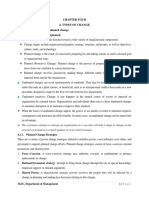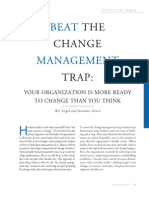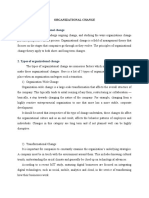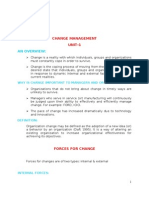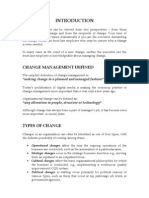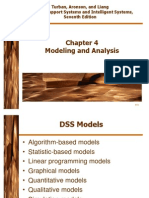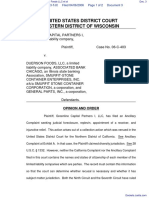Chapter - Four Word
Chapter - Four Word
Uploaded by
tame kibruCopyright:
Available Formats
Chapter - Four Word
Chapter - Four Word
Uploaded by
tame kibruOriginal Description:
Original Title
Copyright
Available Formats
Share this document
Did you find this document useful?
Is this content inappropriate?
Copyright:
Available Formats
Chapter - Four Word
Chapter - Four Word
Uploaded by
tame kibruCopyright:
Available Formats
4.1.
Planned Vs Unplanned Change
CHAPTER FOUR
TYPES OF CHANGE
Planned change occurs when leaders in the organization recognize the need for a major change and
proactively organize a plan to accomplish the change.
Planned change is a change that occurs when leaders or employees make a conscious effort to change in
response to a specific problem. It also occurs with a successful implementation of a strategic plan, a
plan for reorganization, or other implementation of a change of this magnitude.
Note that planned change, even though based on a proactive and well-done plan, often does not occur in a
highly organized fashion. Instead, planned change tends to occur more in a chaotic and disruptive fashion
than expected by participants.
Unplanned change usually occurs because of a major, sudden surprise to the organization, which causes its
members to respond in a highly reactive and disorganized fashion. unplanned change occurs randomly and
spontaneously without any specific intention on the part of managers or employees of addressing a
problem.
Unplanned change might occur when the Chief Executive Officer suddenly leaves the organization,
significant public relations problems occur, poor product performance quickly results in loss of
customers, or other disruptive situations arise.
4.2 Revolutionary Vs Evolutionary Change
Evolutionary change is incremental and takes place gradually, over time. The stages of change are often
so small that those affected don’t even recognize the shift, or they do and they’re able to adjust their
work and processes a little at a time. It’s incremental in that it happens step by step, little by little.
Organizations undergoing evolutionary change may have been prompted by outside pressure, as in
keeping up with technology or addressing the needs of stakeholders more effectively. In other
cases, evolutionary change may be encouraged by competition.
By contrast, Revolutionary or transformational change is profound. When we think of
revolutionary change, we envision complete repair, renovation, and reconstruction. Change is
fundamental, dramatic, and often irreversible. From an organizational perspective, revolutionary change
reshapes and realigns strategic goals and often leads to radical breakthroughs in beliefs
Leadership and change management 1 Chapter
4
or behaviors. When an organization decides to engage in revolutionary change, radical
transformations to products or services often follow. In efforts to stay ahead of the curve and reach
evolution, outstanding organizations often pursue revolutionary change.
Advantages of Revolutionary change
Low risk of the change failing to take effect.
Change will occur quickly.
Change will have any resources needed.
Political cover. For example if another department doesn’t like the change for some reason, and
they escalate to their management, whoever mandated the change feels ownership over it and will
be unlikely to back down. (Aside: this is not necessarily a good thing if the change is at the
expense of the larger organization.)
Looks good on résumés and annual reports.
Feels planned. Mandates that come from the same person often fit together–for example a change
this year to create a new Service Desk, followed by a change next year to implement a
new Service Desk tool.
Disadvantages Revolutionary change
Change may not become part of the culture before focus shifts. The change may roll back a few
months after leadership changes focus.
Loss of political capital: because the change was less inclusive up front, political capital is lost.
Job security for the leader: if the change does not provide the benefit expected, or
otherwise fails, the people who mandated the change may lose their job. (Aside: setting this
expectation is definitely a bad way to manage, as it creates huge incentives for leaders to make the
change look like it worked.)
Opportunity cost: other improvements may be needed but everyone is tied up working on the
mandated improvement.
Not necessarily a “good fit” for the organization: the current situation was likely not
understood well, so the solution applied often leaves pain points or gaps.
Often treats people like robots.
Advantages Evolutionary Change
Highly likely that, if the change is implemented, it will become part of the culture.
More people have been involved in the design.
Leadership and Change Management 2 Chapter
4
More people identify with the change. Likely that the change fits the organization,
understanding the current situation.
More brains around the problem, leading to more thoughtful solutions.
Disadvantages Evolutionary Change
Very risky up front. High likelihood that people will not understand or will not buy in to the
change. Hard to build momentum.
Haphazard. Changes may be introduced that do not move the organization towards where it needs to
go. This is compounded if there is not an organizational “True North” or target condition.
Can be “design-by-committee” where a sense of central direction is lost. Especially true if
there is not one clear owner/change agent.
Hard to find people who are good at making evolutionary change. It is a skill. What’s more,
these people rarely take credit for their work so you might not know who they are.
4.3 Business Process Reengineering (BPR)
Hammer and Champy (1993) defined BPR as “the fundamental rethinking and radical design of business
processes to achieve dramatic improvement in critical measures of performance such as cost, quality service
and speed.” According to Laudon and Laudon (1998), business reengineering is analyzing, simplifying and
redesigning the business process to radically improve the cost and the quality of a product or service.
Another BPR father, Davenport (1993), describes ‘business process redesign’ as: ... the analysis and
design of workflows and processes within and between organizations.
Business activities should be viewed as more than a collection of individual or even functional tasks; they should
be broken down into processes that can be designed for maximum effectiveness, in both manufacturing and
service environment.
BPR is a radical change, rather than an incremental change. Hammer and Champy (1993) highlight this tenet
as: Re-engineering is about rejecting the conventional wisdom and received assumptions of the past.
Reengineering is the search for new models of organizing work. Re-engineering is a new beginning.
Business Process Reengineering involves the radical redesign of core business processes to achieve dramatic
improvements in productivity, cycle times and quality. In Business Process Reengineering, companies start with
a blank sheet of paper and rethink existing processes to deliver more value to the customer. They typically
adopt a new value system that places increased emphasis on
Leadership and Change Management Chapter Page 3
4
customer needs. Companies reduce organizational layers and eliminate unproductive activities in two key
areas. First, they redesign functional organizations into cross-functional teams. Second, they use technology to
improve data dissemination and decision making.
Companies use Business Process Reengineering to improve performance substantially on key processes that
impact customers. Business Process Reengineering can:
Reduce costs and cycle time: Business Process Reengineering reduces costs and cycle times by
eliminating unproductive activities and the employees who perform them. Reorganization by teams
decreases the need for management layers, accelerates information flows, and eliminates the errors and rework
caused by multiple handoffs.
Improve quality: Business Process Reengineering improves quality by reducing the fragmentation of
work and establishing clear ownership of processes. Workers gain responsibility for their output and can
measure their performance based on prompt feedback.
Radical change: In radical change, a key business process is the transformation of organizational
elements; it is essential to the survival of organizations. Change leads to new ideas, technology, innovation,
and improvement. Therefore, it is important that organizations recognize the need for change and learn to
manage the process effectively.
Challenges in BPR
Process Simplification is common Process under review too big or too
Desire to change not strong enough small
Start point the existing process not a Reliance on existing process too strong
Blank slate Cost of change seems too large
Commitment to existing processes too Allocation of resources
strong
Poor timing & planning
Quick Fix approach
Keeping the team & org on target
70% of the BPR projects fail.
Biggest obstacles that reengineering faces are:
(i) Lack of sustained management commitment and leadership;
(ii) Unrealistic scope and expectations; and
(iii) Resistance to Change.
Leadership and Change Management 4 Chapter
4
4.4 BPR process
Business processes are market-centered descriptions of an organization’s activities.
Business processes are collections of one or more linked activities which realize a business objective or policy
goal such as fulfilling a business contract, and/or satisfying a specific customer need. The lifecycle of a
business process involves everything from capturing the process in a computerized representation to
automating the process.
i) Develop the business vision and process objectives: BPR is driving by a business vision
which implies specific business objectives such as cost reduction, time reduction, output quality
improvement, quality of work life.
ii) Identify the processes to be redesigned: Most firms use high- impacts approach which
focuses and most important processes or those that conflict most with the business vision. Few
numbers of firms use the exhaustive approach that attempts to identify all the processes
within an organization and then prioritize them in order to redesigned urgency.
iii) Understand and measure the existing process: For avoiding the repeating of old mistake and
for providing a baseline for future improvements.
iv) Identity information technology (IT) levels: Awareness of IT capabilities can and should
influence process.
v) Design and Build a prototype of New Process: The actual design should not be viewed as
the end of the BPR process. Rather, it should be viewed as a prototype, aligns the BPR approach
with quick delivery of results and the involvement and satisfaction of customers.
4.5 BPR techniques and tools
When a BPR project is undertaken across the organization, it can require managing a massive amount
of information about the processes, data and systems. If you don't have an excellent tool to support BPR,
the management of this information can become an impossible task. The use of a good BPR/documentation
tool is vital in any BPR project. The tools of BPR include:
Purpose analysis (To identify the objectives.)
Process Activity Analysis is our own (superior in terms of comprehensiveness and identifying waste)
brand of what is sometimes called "Value Stream Mapping" or "Flowcharting" (To identify current
or future information, material, or document flows.)
Waste analysis (To identify waste in the current process.) We use our three proprietary
techniques to establish waste:
o Complexity, Variability, Analysis
Leadership and Change Management Chapter Page 5
4
o Agility Analysis (Self diagnosis available on request) (It is applicable to non
manufacturing businesses.)
Ownership Analysis (To identify changes of ownership of material, information or documents during
their life.)
Benchmarking (To identify alternative strategies, organization, processes, procedures and
methods.)
Resource Domination Analysis (To identify what products or services consume what
resources.)
Product life cycle analysis (To identify whether investment in particular products and
processes are worthwhile.)
Force field analysis (To identify cultural constraints)
Pareto Analysis (To sort the wheat from the chaff, in products, processes, value, space
utilization etc.)
Segmentation (A method of virtually or actually segmenting the business or processes.)
Input / Process / Output diagrams (A method of defining a process)
Control Systems Design (A method of identifying appropriate control systems techniques for the new
situation.)
Measures of Performance Design (A method of identifying how the new process will be
measured.)
4.6 Implementation of BPR
Generally, the topic of BPR involves discovering how business processes currently operate, how to redesign
these processes to eliminate the wasted or redundant effort and improve efficiency, and how to implement
the process changes in order to gain competitiveness. The aim of BPR, is “seeking to devise new ways of
organizing tasks, organizing people and redesigning IT systems so that the processes support the
organization to realize its goals”.
BPR seeks to break from current processes and to devise new ways of organizing tasks, organizing people and
making use of IT systems so that the resulting processes will better support the goals of the organization.
This activity is done by identifying the critical business processes, analyzing these processes and
redesigning them for efficient improvement and benefit.
Leadership and Change Management 6 Chapter
4
4.7 Other kinds of Change
Organization-wide versus Subsystem Change
Examples of organization-wide change might be a major restructuring, collaboration or “right- sizing.”
Usually, organizations must undertake organization-wide change to evolve to a different level in their life
cycle, for example, going from a highly reactive, entrepreneurial organization to one that has a more stable
and planned development. Experts assert that successful organizational change requires a change in culture
– cultural change is another example of organization-wide change.
Examples of a change in a subsystem might include addition or removal of a product or service,
reorganization of a certain department, or implementation of a new process to deliver products or services.
Remedial Versus Developmental Change
Change can be intended to remedy current situations, for example, to improve the poor
performance of a product or the entire organization, reduce burnout in the workplace, help the
organization to become much more proactive and less reactive, or address large budget deficits. Remedial
projects often seem more focused and urgent because they are addressing a current, major problem. It is
often easier to determine the success of these projects because the problem is solved or not. Change can
also be developmental – to make successful situation even more successful, for example, expand the
amount of customers served, or duplicate successful products or services.
Developmental projects can seem more general and vague than remedial, depending on how specific
goals are and how important it is for members of the organization to achieve those goals. Some people
might have different perceptions of what is a remedial change versus a developmental change. They
might see that if developmental changes are not made soon, there will be need for remedial changes
A comparative brief analysis of BPR, TQM and KAIZEN
BPR is different from TQM in that BPR concentrates on major discrete changes to business processes, whereas
TQM concentrates on minor continuous improvements to business processes. That is, the improvements in
TQM are smaller than the ones in BPR.
The basic assumptions of TQM and BPR are different. TQM assumes that the existing practices or systems
are principally right and useful. The target of TQM is to improve on the basis of the existing system.
However, BPR takes the opposite assumption. BPR assumes the existing system is useless and
Leadership and Change Management Chapter Page 7
4
suggests starting it over. Unlike, TQM which aims at smooth and incremental improvements, BPR aims for
dramatic results.
Furthermore, whereas BPR is commonly viewed as a top-down solution by management, TQM involves
staff from all levels for problem-solving and suggests bottom-up improvement. Employees’ resistance to
change has been identified as one major barrier to the success of BPR.
The differences between TQM and BPR efforts can be summarized by the following table 1:
What is Kaizen?
Kaizen is a Japanese word, which denotes ‘improvement’. Some Kaizen theory proponents opine that
Kaizen also stands for ‘any change for the better’. Even though this word had been coined by the Japanese
and made famous, the origin of “Gai’ and ‘zhen’. The principles and practices of Kaizen focus on
continuous improvement in manufacturing, management, engineering, and other supporting business
processes.
The Kaizen philosophy had been applied in a Kaizen refers to the entire gamut of activities that improve
all the related functions on a continuous basis. Further, Kaizen is not a localized application but involves all the
employees in an organization right from the CEO, extending to even the basic assembly line workers.
Moreover, the Kaizen practices are applied to processes in external areas of operations also, such as
purchases, logistics, and other supply chain activities that function outside boundaries of the organization.
The basic purpose of Kaizen is to eliminate all wastes in business processes by improving the
standardization in all the processes and activities of an organization.
Leadership and Change Management 8 Chapter
4
Kaizen and Balanced Scorecard (BSC) for change management
Balanced scorecards focus on four perspectives of business process, learning and growth, financial, and
customer. Whether an organization is small or large, balanced scorecards are very important in measuring
the performance metrics of the employees and the business processes. BSCs are believed to bring in the
3R advantages to every business.
The 3Rs are known as doing Right things, doing them Right, and doing them at the Right time. In the present
competitive environment that had become global for many industries, the traditional performance
measurement metrics are required to be aligned with the new and evolving strategies. Only dynamic
strategies would be able to address and adapt to changing business environmental conditions. For correction
implementation of the 3Rprinciples, the management and employees should understand the importance of
rethinking in the strategic planning of the business systems.
They should comprehend the process of scorecard creation and the proper efforts for process
improvement.Kaizen has got a few similarities with balanced improvement in productivity and quality,
enhanced customer satisfaction, reduction in the cost of operations, and increase in profits. As such, Kaizen
covers the three major perspectives of balanced scorecard, namely, difference between Kaizen and balanced
scorecards. Kaizen is a strategy for continuous improvement in all the areas of business. On the other hand,
balanced scorecard is a performance measurement metrics tool that provides an idea of the present
performance level and possible future trends.
For maximum benefits and advantages in business success, each organization should integrate the Kaizen
principles with the balanced scorecards. The data scorecards would clearly indicate areas of deficiency. The
Kaizen techniques should be applied in such areas without delay to remedy the situation and remove the
deficiency.
To sum up, TQM - Total Quality Management and BPR share a lot common themes as they both focus on
customer requirements and processes to fulfill them, however, they differ significantly as the pace of
change and improvement is concerned, as well as on the means of accomplishment.
While BPR is intended to achieve quantum gains rapidly by replacing old processes with new ones, TQM
and other quality programs are working on the basis of existing processes and seek to enhance them by
incremental, continuous improvement, a process even known by the Japanese term "kaizen". When Kaizen is
compared with the BPR method is it clear the Kaizen philosophy is more people-oriented, more easy to
implement, but requires long-term discipline and provides only a small pace of change. The Business
Process Reengineering approach on the other hand is harder, technology-oriented, it enables radical change
but it requires considerable change management skills.
Leadership and Change Management Chapter Page 9
4
Why different changes failed?
Because, in many cases, a good strategic plan may not be fully implemented for a number of
barriers, such as vision barriers, people barriers, resource barrier, and management barriers. These are briefly
explained as under:
Vision barrier– No one in the organization understands the strategies of the organization.
People barrier– Most people have objectives that are not linked to the strategy of the organization.
Resource barrier– Time, energy, and money are not allocated to those things that are critical to the
organization. For example, budgets are not linked to strategy, resulting in wasted resources.
Management barrier– Management spends too little time on strategy and too much time on short- term
tactical decision-making.
Leadership and Change Management 1 Chapter
0 4
Leadership and change management 11 Chapter
4
You might also like
- Change Management AssignmentDocument7 pagesChange Management AssignmentMfaeez Fiz33% (3)
- Changemaking: Tactics and Resources for Managing Organizational ChangeFrom EverandChangemaking: Tactics and Resources for Managing Organizational ChangeNo ratings yet
- Concept and Principle of Change MGMTDocument19 pagesConcept and Principle of Change MGMTTesfahun TegegnNo ratings yet
- Change ManagementDocument17 pagesChange ManagementMeenakshi Bisht Rawat100% (2)
- Change ManaementDocument16 pagesChange ManaementMuhammad ImranNo ratings yet
- Acceptance Criteria For Damaged PFP Info Sheet 12-2007Document9 pagesAcceptance Criteria For Damaged PFP Info Sheet 12-2007Richard HollidayNo ratings yet
- Organisational ChangeDocument5 pagesOrganisational Change210525251No ratings yet
- CHAPTER 4 EditedDocument9 pagesCHAPTER 4 EditedSMON HABESHNo ratings yet
- Chapter Four 4. Types of Change 4.1. Planned Versus Unplanned ChangeDocument8 pagesChapter Four 4. Types of Change 4.1. Planned Versus Unplanned ChangeMelkamu TemesgenNo ratings yet
- Leadership CH-4Document20 pagesLeadership CH-4Nathnael BirhanuNo ratings yet
- Ebook Leading Change FocusUDocument21 pagesEbook Leading Change FocusUYaw KissiNo ratings yet
- Leadership Chapter 4Document20 pagesLeadership Chapter 4Abelooo OoNo ratings yet
- Changed Planning For Planned and Unplanned ChangeDocument13 pagesChanged Planning For Planned and Unplanned ChangeArayaselasie TechaluNo ratings yet
- Change Management - Slaying The MythsDocument2 pagesChange Management - Slaying The Mythsthomasderz1961No ratings yet
- ORGANIZATIONAL CHANGE Prof. CordineteDocument23 pagesORGANIZATIONAL CHANGE Prof. CordineteChris CordineteNo ratings yet
- CHAPTER FOUR Types of ChangeDocument3 pagesCHAPTER FOUR Types of ChangetesfaNo ratings yet
- Change ManagementDocument28 pagesChange ManagementSohaib RaufNo ratings yet
- Leadership CH 3-5 SlideDocument20 pagesLeadership CH 3-5 SlideMndaNo ratings yet
- OD and Change AssignmentDocument16 pagesOD and Change AssignmentUsmanNo ratings yet
- Change Management 2019Document12 pagesChange Management 2019Nguyen100% (1)
- Chapter 4 Leadership and Change Management - EditedDocument45 pagesChapter 4 Leadership and Change Management - Editedhasenabdi30No ratings yet
- Change ManagementDocument10 pagesChange Managementnagarajan1No ratings yet
- 5 Types of Organizational ChangeDocument9 pages5 Types of Organizational ChangekookyinNo ratings yet
- Bus 1.4 - Managing Change (3) Level 4 AssignmentsDocument13 pagesBus 1.4 - Managing Change (3) Level 4 AssignmentsDave Pulpulaan100% (1)
- Problems of Change in An Organization-1!!!!Document14 pagesProblems of Change in An Organization-1!!!!Olayiwola TemileyiNo ratings yet
- Change MGMT ExamplesDocument19 pagesChange MGMT Examplesjyoti chauhanNo ratings yet
- Change Management TrapDocument9 pagesChange Management TrapNguyên Thanh Nguyên ThủyNo ratings yet
- LIYA TADESSE Change Management AssignmentDocument10 pagesLIYA TADESSE Change Management Assignmentአረጋዊ ሐይለማርያም100% (1)
- Change Management 1Document50 pagesChange Management 1rocknroll_mahive1789No ratings yet
- Change ManagementDocument7 pagesChange Managementfaizanq680No ratings yet
- Effective Change ManagementDocument8 pagesEffective Change Managementjy197850% (2)
- ChangeDocument32 pagesChangeSofia JamwalNo ratings yet
- Under Supervision of Prof. DR: Maha Shokir Prepared By: Organizational Change &human ResoursesDocument35 pagesUnder Supervision of Prof. DR: Maha Shokir Prepared By: Organizational Change &human ResoursesWafaa ShadyNo ratings yet
- ORGANIZATIONAL DEVELOPMENT - Unit 3.1.4 & Unit 3.1.5Document11 pagesORGANIZATIONAL DEVELOPMENT - Unit 3.1.4 & Unit 3.1.5Medalia TalicuadNo ratings yet
- Management of Change NotesDocument29 pagesManagement of Change Notes4mx9t6tcz9No ratings yet
- Group 7Document6 pagesGroup 7Sky CastleNo ratings yet
- Managing Change and InnovationDocument8 pagesManaging Change and InnovationTahreem ZaeemNo ratings yet
- Chapter 14: Managing Strategic ChangeDocument50 pagesChapter 14: Managing Strategic Changebreakarzyahoo.comNo ratings yet
- CH 3Document18 pagesCH 3Nathnael BirhanuNo ratings yet
- Change Management NotesDocument42 pagesChange Management NotesLinos TichazorwaNo ratings yet
- Principles of ManagementDocument11 pagesPrinciples of Managementaishwarya.horizonNo ratings yet
- Change Management PDFDocument6 pagesChange Management PDFAbunadzrin AbdulajeedNo ratings yet
- Basics of Change ManagementDocument33 pagesBasics of Change Managementisaac100% (2)
- Managing Organisational ChangeDocument5 pagesManaging Organisational ChangeHera RachmahaniNo ratings yet
- Change ManagementDocument12 pagesChange Managementrevdambogo100% (1)
- Term Paper MpobDocument13 pagesTerm Paper Mpobsoniasharma07No ratings yet
- An Overview:: Change Management UNIT-1Document13 pagesAn Overview:: Change Management UNIT-1Ram KumarNo ratings yet
- Sony KodakDocument54 pagesSony KodakNilesh SolankiNo ratings yet
- Change Management: Yatin Kumar Preet Ratan SinghDocument24 pagesChange Management: Yatin Kumar Preet Ratan SinghyatinNo ratings yet
- Building Capability For Effective Implementation of ChangeDocument20 pagesBuilding Capability For Effective Implementation of ChangeMaven Training100% (1)
- 2 Focus of Organization ChangeDocument28 pages2 Focus of Organization Changesxcsh88100% (2)
- BMGT 300 - Topic Nine Management of Change - 221012 - 161249Document17 pagesBMGT 300 - Topic Nine Management of Change - 221012 - 161249Pa HabbakukNo ratings yet
- Leading Sustainable Organization ChangeDocument5 pagesLeading Sustainable Organization Changepankaj_mbmNo ratings yet
- BA Strategic ActionDocument36 pagesBA Strategic ActionNguyễn HoaNo ratings yet
- Organisational BehaviourDocument12 pagesOrganisational Behaviourabhi malikNo ratings yet
- R-9 Ryan Case Steps in Change ManagementDocument6 pagesR-9 Ryan Case Steps in Change ManagementRajpratap Kourav189No ratings yet
- Change ManagementDocument7 pagesChange ManagementSOFIA MIRZA100% (2)
- Notes - Managing Organizational Change - Updated - To Be Sent To StudentsDocument14 pagesNotes - Managing Organizational Change - Updated - To Be Sent To StudentsNash SharmaNo ratings yet
- CMOD - Week 2Document24 pagesCMOD - Week 2NataljaNo ratings yet
- The Modern Mantra For Innovative Management Is "Managerial Effectiveness"Document4 pagesThe Modern Mantra For Innovative Management Is "Managerial Effectiveness"Nur Al AhadNo ratings yet
- Change Insight: Change as an Ongoing Capability to Fuel Digital TransformationFrom EverandChange Insight: Change as an Ongoing Capability to Fuel Digital TransformationRating: 5 out of 5 stars5/5 (2)
- MesayworkDocument21 pagesMesayworktame kibruNo ratings yet
- Chapter 6 Security AnalysisDocument13 pagesChapter 6 Security Analysistame kibruNo ratings yet
- Chapter 5 Stock AND Equity ValuationDocument9 pagesChapter 5 Stock AND Equity Valuationtame kibruNo ratings yet
- OM Chap1Document58 pagesOM Chap1tame kibruNo ratings yet
- Attachment (1) 2222Document18 pagesAttachment (1) 2222tame kibru100% (2)
- Proposal AssignmentDocument18 pagesProposal Assignmenttame kibruNo ratings yet
- Chapter 1Document24 pagesChapter 1tame kibruNo ratings yet
- Model Exit Exam 7Document23 pagesModel Exit Exam 7tame kibruNo ratings yet
- Accounting For Public OrganizationsDocument54 pagesAccounting For Public Organizationstame kibruNo ratings yet
- CH1 Overview of InvetmentDocument12 pagesCH1 Overview of Invetmenttame kibruNo ratings yet
- Model Exit Exam 6Document19 pagesModel Exit Exam 6tame kibruNo ratings yet
- Forestry Model Exam 2024Document13 pagesForestry Model Exam 2024tame kibruNo ratings yet
- Model A.A University 2Document80 pagesModel A.A University 2tame kibruNo ratings yet
- Advanced FA I&IIDocument99 pagesAdvanced FA I&IItame kibruNo ratings yet
- FM I Exit SummDocument119 pagesFM I Exit Summtame kibruNo ratings yet
- Chapter 10 Project ManagementDocument49 pagesChapter 10 Project Managementtame kibruNo ratings yet
- FM II Ch-1Document13 pagesFM II Ch-1tame kibruNo ratings yet
- FM II Ch-5Document5 pagesFM II Ch-5tame kibruNo ratings yet
- Advanced FA II CH4Document60 pagesAdvanced FA II CH4tame kibruNo ratings yet
- MitiDocument10 pagesMititame kibruNo ratings yet
- NTFP Reading MaterialDocument176 pagesNTFP Reading Materialtame kibruNo ratings yet
- PBM Ch-2Document22 pagesPBM Ch-2tame kibruNo ratings yet
- NormalDocument51 pagesNormaltame kibruNo ratings yet
- MariamDocument25 pagesMariamtame kibruNo ratings yet
- Aud 2 CH 6-1Document9 pagesAud 2 CH 6-1tame kibruNo ratings yet
- Fiche, Ethiopia DECEMBER, 2023Document22 pagesFiche, Ethiopia DECEMBER, 2023tame kibruNo ratings yet
- PBM Ch-1Document23 pagesPBM Ch-1tame kibruNo ratings yet
- KEMAL Final Pro 11Document28 pagesKEMAL Final Pro 11tame kibruNo ratings yet
- Open Channel Flow Uf GVFDocument86 pagesOpen Channel Flow Uf GVFtame kibruNo ratings yet
- Salale University 1223Document22 pagesSalale University 1223tame kibruNo ratings yet
- Hydrocarbon Processing 10 2016 PDFDocument153 pagesHydrocarbon Processing 10 2016 PDFDivyesh Patel100% (5)
- Sun Tracking Solar PanelDocument45 pagesSun Tracking Solar PanelMisbah SaifNo ratings yet
- Huong Dan Cai May inDocument2 pagesHuong Dan Cai May inChristian HoàngNo ratings yet
- Chapter 4 Decision Support System (Dr. Mahmoud Mostafa)Document32 pagesChapter 4 Decision Support System (Dr. Mahmoud Mostafa)JonathanHindiNo ratings yet
- 8 Principles of BIGDocument2 pages8 Principles of BIGAdonis Miñano0% (1)
- Three Key Considerations When Selecting Synthetic Turf For Collegiate AthleticsDocument4 pagesThree Key Considerations When Selecting Synthetic Turf For Collegiate AthleticsDecca Urban EcoNo ratings yet
- Corporate Sustainability and Financial Performance of Bangladeshi BanksDocument56 pagesCorporate Sustainability and Financial Performance of Bangladeshi BanksPaul DonNo ratings yet
- AustinHams SDRDocument32 pagesAustinHams SDRJos1No ratings yet
- HI 801 171 E HIMax Maintenance ManualDocument16 pagesHI 801 171 E HIMax Maintenance ManualRoberto FinaNo ratings yet
- Special Publication 42Document48 pagesSpecial Publication 42Zaher J. Yazeji100% (1)
- EIA Checklist 2018135154Document5 pagesEIA Checklist 2018135154Abdullah All RifatNo ratings yet
- Ash Brown Hair - Google PenelusuranDocument1 pageAsh Brown Hair - Google PenelusuranFitriani DanishaNo ratings yet
- Greenline Capital Partners I LLC v. Duerson Foods LLC Et Al - Document No. 3Document2 pagesGreenline Capital Partners I LLC v. Duerson Foods LLC Et Al - Document No. 3Justia.comNo ratings yet
- Karina Fabi - Price Action For AllDocument142 pagesKarina Fabi - Price Action For AllMOYENUL HASANNo ratings yet
- Ama Computer College V Jesus FactoraDocument2 pagesAma Computer College V Jesus FactoraColee StiflerNo ratings yet
- Atlas Copco Weda Small Range Pumps: Fast and Effective Dewatering in Small Packages 50HzDocument2 pagesAtlas Copco Weda Small Range Pumps: Fast and Effective Dewatering in Small Packages 50HzGuptaNo ratings yet
- Essential Performance.: The Easiest Way To Get All The Speed of A New Computer Without The PriceDocument3 pagesEssential Performance.: The Easiest Way To Get All The Speed of A New Computer Without The PriceAlfredo RojasNo ratings yet
- Taxation 2 Case DigestsDocument148 pagesTaxation 2 Case DigestsAncheden Ancheden100% (1)
- The Global Health Workforce Crisis Task Shifting As The Solution Nigeria Case StudyDocument42 pagesThe Global Health Workforce Crisis Task Shifting As The Solution Nigeria Case StudyRangaFernandoNo ratings yet
- AMMDocument2,113 pagesAMMДенис ГаценкоNo ratings yet
- Rieta Vs People, Salvador Vs PeopleDocument2 pagesRieta Vs People, Salvador Vs Peopleanalyn123No ratings yet
- Processing Thermosets CompositesDocument31 pagesProcessing Thermosets CompositesyigitilgazNo ratings yet
- Consumer CirDocument1 pageConsumer CirLeo ManiNo ratings yet
- Salimbangon Vs TanDocument4 pagesSalimbangon Vs Tanlovekimsohyun89No ratings yet
- Unit - 3 IotDocument39 pagesUnit - 3 IotkaveripadmabaswaNo ratings yet
- Satellite Applications PDFDocument12 pagesSatellite Applications PDFchris hortonNo ratings yet
- SECTION 03200 Concrete ReinforcementDocument8 pagesSECTION 03200 Concrete ReinforcementSuranga ManuNo ratings yet
- Ilovepdf MergedDocument20 pagesIlovepdf MergedDeb Sankar MukhopadhyayNo ratings yet
- European Journal of Scientific Research PDFDocument2 pagesEuropean Journal of Scientific Research PDFMarcusNo ratings yet








